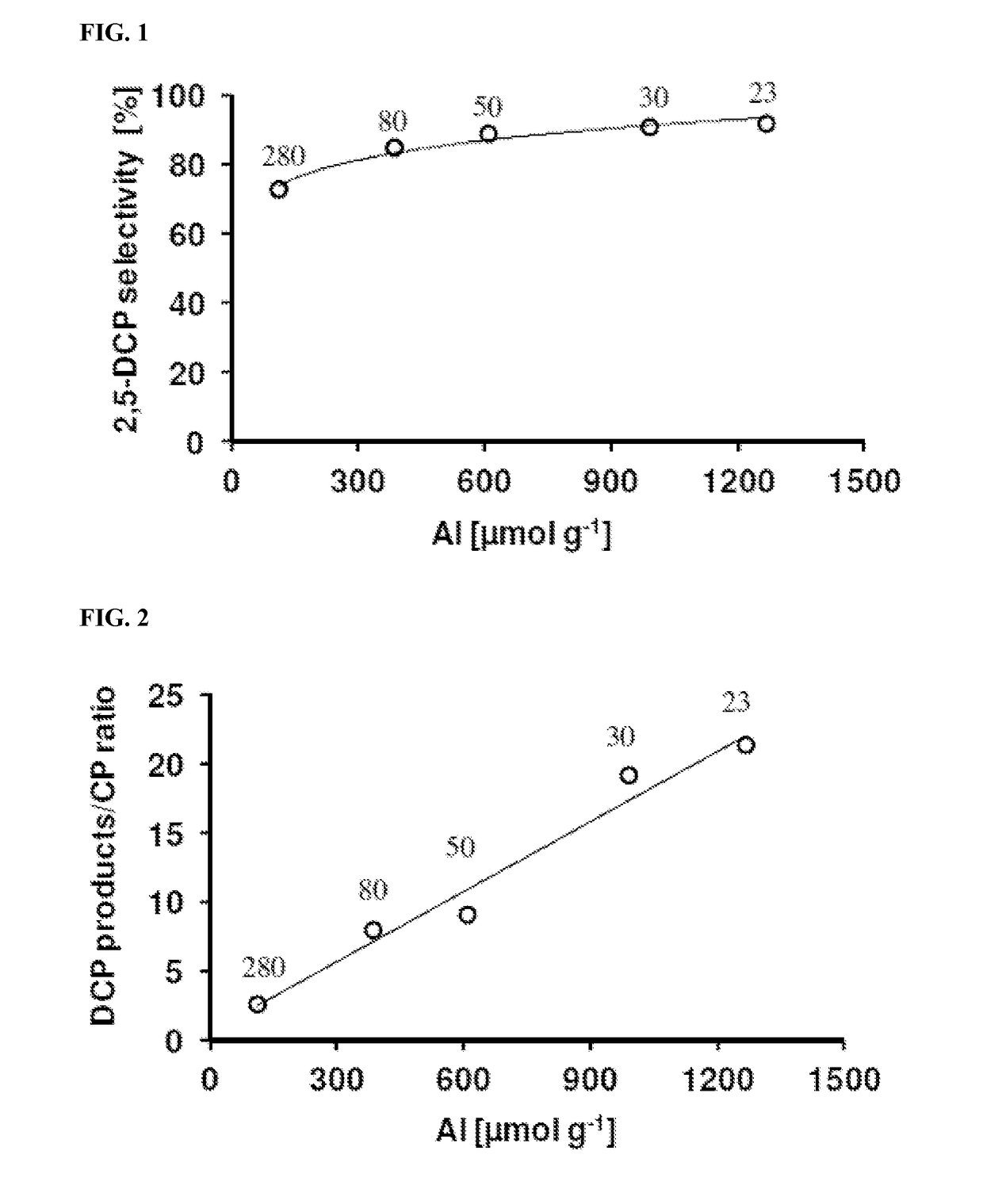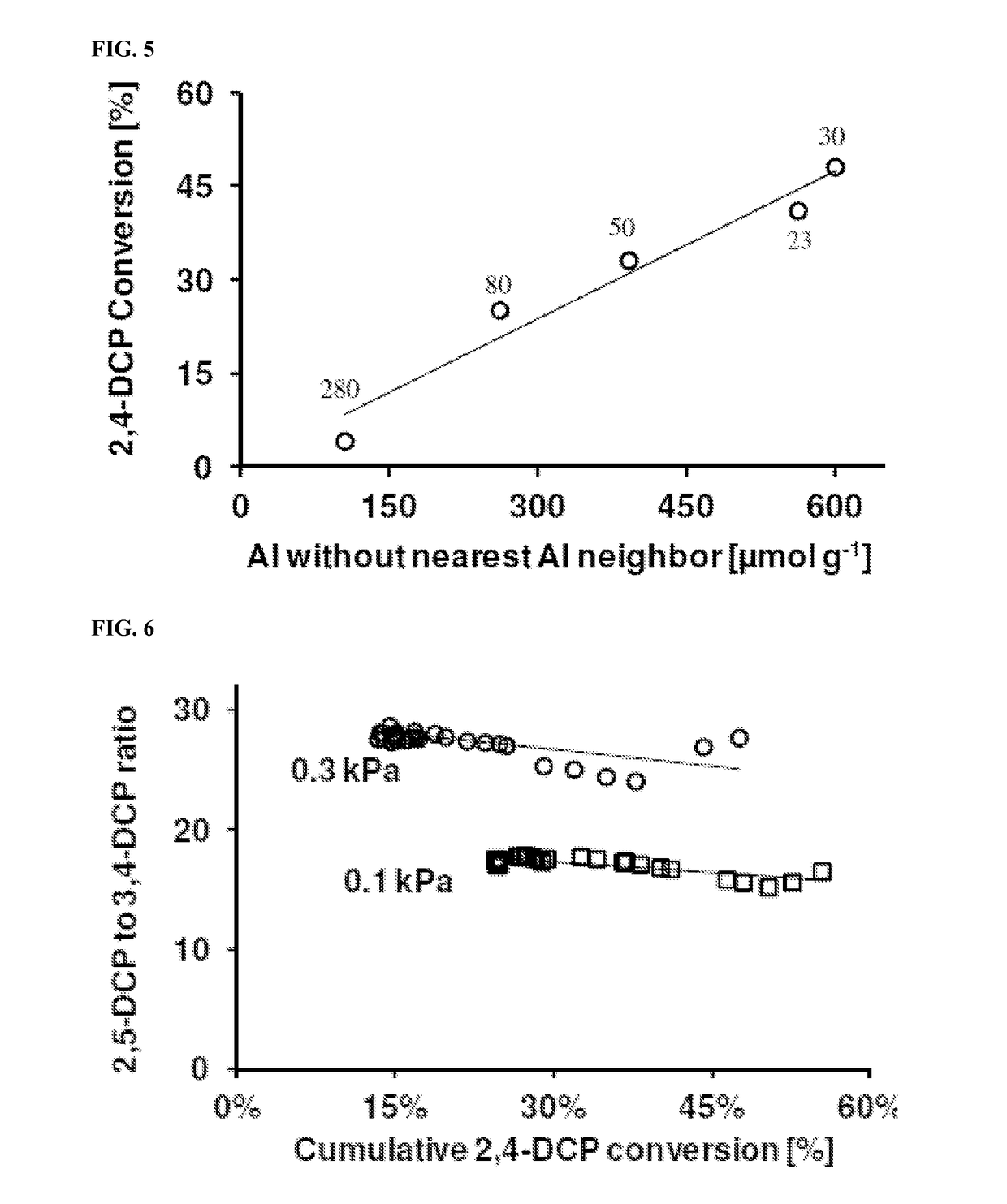Processes for preparing 2,5-dichlorophenol
a technology of 2,5-dichlorophenol and process, which is applied in the preparation of carboxylic compounds, physical/chemical process catalysts, organic chemistry, etc., can solve the problems of high raw material cost, low process conversion and selectivity, and difficult process for producing dicamba
- Summary
- Abstract
- Description
- Claims
- Application Information
AI Technical Summary
Benefits of technology
Problems solved by technology
Method used
Image
Examples
example 1
ormance Liquid Chromatography (“HPLC”) Analytical Methods
A. HPLC Method for Determination of Chlorinated Phenols
[0091]HPLC analysis used to monitor the compositions of isomerization reaction was conducted on an Agilent 1260 Infinity Analytical HPLC System equipped with a diode array UV detector and monitored at 220 nm. The column was a X-Bridge C18, 4.6×150 mm, 3.5 micron with a pre-column filter and the column temperature was at 30° C. The HPLC was conducted at a flow rate of 2 mL / minute of mobile phase A (85% water, 15% acetonitrile) and mobile phase B (100% acetonitrile) as described in Tables 1-A1 and 1-A2 below:
TABLE 1-A1HPLC Method for Determination of Chlorinated PhenolsTIME% MPA% MPB0.00851517.50851517.5159520.0059520.10851524.008515
TABLE 1-A2Retention Times of Monochlorophenols and Dichlorophenolsby Chlorinated Phenol MethodRetentionRetentionTimeTimeMonochlorophenols(minute)Dichlorophenols(minute)2-Chlorophenol4.892,6-Dichlorophenol9.544-Chlorophenol6.132,3-Dichlorophenol12...
example 3
Time-On-Stream on Selectivity and Conversion of Isomerization
[0095]Example 2 was repeated except a HZSM-5 catalyst having SiO2 / Al2O3 mole ratios of 30 and 50 were used. The catalyst temperature was maintained at 300° C. Extended time-on-stream was evaluated for both selectivity and conversion of the reaction. The results of this experiment are provided in Table 3.
TABLE 3Selectivity and Conversion vs. Time-on-streamExp. No. 3.1Exp. No. 3.2SiO2 / Al2O3 mole ratio = 50SiO2 / Al2O3 mole ratio = 30Time-on-2,5-DCP2,4-DCPTime-on-2,5-DCP2,4-DCPStreamSelec-Conver-StreamSelec-Conver-(hours)tivity (%)sion (%)(hours)tivity (%)sion (%)287412915248427491448842089035128417129129248313239124368310359119498394991167184871911580849——————969114
[0096]The results show that the catalyst is consistently selective for 2,5-dichlorophenol and that conversion of 2,4-dichlorophenol is maintained over extended periods of time-on-stream. The results also show that the catalyst can be used in these reaction condition...
example 4
2,4-DCP Partial Pressure on Selectivity and Conversion of Isomerization
[0097]Example 2 was repeated except a HZSM-5 catalyst having a SiO2 / Al2O3 mole ratio of 30 was used and 2,4-dichlorophenol partial pressure was varied from 0.05 kPa to 0.3 kPa and temperature was varied from 300° C. to 320° C. The results of this experiment are provided in Table 4.
TABLE 4Selectivity and Conversion vs. 2,4-DCP Partial Pressure2,4-DCP2,4-DCPWeightSteady-CatalystGas Flowpartialover feed2,5-DCPstateExp.SiO2 / Al2O3TemperatureRatepressure(gram ×SelectivityConversionNo.mole ratio(° C.)(cm3 / min)(kPa)sec / gram)(%)(%)4.1303003450.12400090254.2303003450.37200093154.3303203450.052400090324.4303203450.3720009217
[0098]The results show that increasing the partial pressure of 2,4-dichlorophenol increased 2,5-dichlorophenol selectivity. FIGS. 6 and 7 show the ratio of 2,5-dichlorophenol to 3,4-dichlorophenol at the tested partial pressures of 2,4-dichlorophenol. The ratio of 2,5-dichlorophenol to 3,4-dichlorophenol...
PUM
| Property | Measurement | Unit |
|---|---|---|
| mole ratio | aaaaa | aaaaa |
| weight ratio | aaaaa | aaaaa |
| mole ratio | aaaaa | aaaaa |
Abstract
Description
Claims
Application Information
 Login to View More
Login to View More - R&D
- Intellectual Property
- Life Sciences
- Materials
- Tech Scout
- Unparalleled Data Quality
- Higher Quality Content
- 60% Fewer Hallucinations
Browse by: Latest US Patents, China's latest patents, Technical Efficacy Thesaurus, Application Domain, Technology Topic, Popular Technical Reports.
© 2025 PatSnap. All rights reserved.Legal|Privacy policy|Modern Slavery Act Transparency Statement|Sitemap|About US| Contact US: help@patsnap.com



